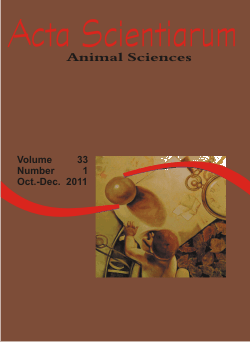<b>Maltodextrin in diets for weaning pigs of different weights: performance and intestinal morphometry</b> - doi: 10.4025/actascianimsci.v33i1.9948
Keywords:
villi height, thickness of the mucosa, lactose, depth of the crypt
Abstract
Two trials were conducted: in the first trial, 96 weaning pigs at the age of 21 days were used, in a block design, with a 2 x 2 factorial arrangement (two sources of carbohydrate and two weaning weight classes). In the second trial, 48 pigs were used, in a block design, with 2 x 2 x 2 x 3 factorial arrangement (two weaning weight classes x two sources of carbohydrate x two portions of the small intestine x three slaughter periods). The effects of the replacement of lactose by maltodextrin in diets of weaning pigs, with different weights, were evaluated on daily feed intake, daily weight gain, feed:gain ratio, villus height, crypt depth and thickness of the mucosa. In the first trial, from 0 to 17 days and from 0 to 29 days after weaning, effects of weight classes were detected on daily weight gain and daily feed intake. In the second trial, maltodextrin resulted in an increase in the average thickness of the intestinal mucosa and in average crypt depth, only in lighter animals. Maltodextrin can be used as an alternative to lactose in diets of weaning pigs.Downloads
Download data is not yet available.
Published
2011-02-02
How to Cite
Augusto, R. M. N., Berto, D. A., Tierzo, V. L., Mello, G. de, Hauptli, L., & Lucchesi, L. (2011). <b>Maltodextrin in diets for weaning pigs of different weights: performance and intestinal morphometry</b> - doi: 10.4025/actascianimsci.v33i1.9948. Acta Scientiarum. Animal Sciences, 33(1), 41-46. https://doi.org/10.4025/actascianimsci.v33i1.9948
Issue
Section
Nonruminant Nutrition
DECLARATION OF ORIGINALITY AND COPYRIGHTS
- I Declare that current article is original and has not been submitted for publication, in part or in whole, to any other national or international journal.
The copyrights belong exclusively to the authors. Published content is licensed under Creative Commons Attribution 4.0 (CC BY 4.0) guidelines, which allows sharing (copy and distribution of the material in any medium or format) and adaptation (remix, transform, and build upon the material) for any purpose, even commercially, under the terms of attribution.
Read this link for further information on how to use CC BY 4.0 properly.
0.9
2019CiteScore
29th percentile
Powered by 








































